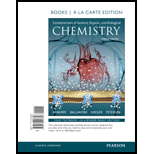
Concept explainers
Interpretation:
The volume of the air in the tank at
Concept Introduction:
Different laws have been put forward to introduce properties of gases:
Boyle’s law:
At fixed temperature, the volume of a fixed amount of gas is inversely proportional to the pressure exerted by the gas.
Charles’s law: States that volume is directly proportional to temperature when the gas is held
at constant pressure and number of molecules.

General
Want to see the full answer?
Check out a sample textbook solution
Chapter 8 Solutions
Modified Masteringchemistry With Pearson Etext -- Valuepack Access Card -- For Fundamentals Of General, Organic, And Biological Chemistry
- According to Dalton’s law, what is the partial pressure of amixture of gases? What is water vapor pressure?arrow_forwardA balloon occupies a volume of 1.25 L at sea level where the ambient pressure is 1 atm. What volume would the balloon occupy at an altitude of 10,700 m, where the air pressure is only 220 mmHg?arrow_forward15.0 L of an ideal gas at 298 K and 3.36 atm are heated to 383 K with a new pressure of 6.05 atm. What is the new volume in liters?arrow_forward
- A helium gas cylinder of the sort used to fill balloons has a volume of 0.180 m3 and a pressure of 150 X 105 Pa (150 atm) at 298 K (25 °C). How many moles of helium are in the tank? How many grams?arrow_forwardA typical room is 4.0 m long, 5.0 m wide, and 2.5 m high. What is the total mass of the oxygen in the room assuming that the gas in the room is at STP and that air contains 21% oxygen and 79% nitrogen?arrow_forwardIf 18.0 g of O2 gas has a temperature of 350 K and a pressure of 550 mmHg, what is its volume?arrow_forward
- A bicycle pump contains 0.682 liters of air at 99.3 kpa . If the handle is pressed down decreasing the volume of the inside air to 0.151 L, what is the pressure inside the pump ? Assume temperature is constantarrow_forwardA cylinder of gas at room temperature (20 degrees Celsius) has a pressure P1. To what temperature in degrees Celsius would the temperature have to be increased for the pressure to be 1.2p1?arrow_forwardNitric acid can be produced by the reaction ofgaseous nitrogen dioxide with water.3 NO2(g) + H2O(ℓ) −→2 HNO3(ℓ) + NO(g)If 956 L of NO2 gas react with water, whatvolume of NO gas will be produced? Assume the gases are measured under the sameconditionsarrow_forward
- Basic Clinical Lab Competencies for Respiratory C...NursingISBN:9781285244662Author:WhitePublisher:Cengage
 Principles Of Radiographic Imaging: An Art And A ...Health & NutritionISBN:9781337711067Author:Richard R. Carlton, Arlene M. Adler, Vesna BalacPublisher:Cengage Learning
Principles Of Radiographic Imaging: An Art And A ...Health & NutritionISBN:9781337711067Author:Richard R. Carlton, Arlene M. Adler, Vesna BalacPublisher:Cengage Learning




